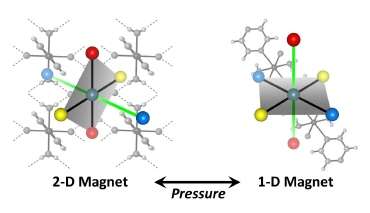Magnetic switching under pressure

(PhysOrg.com) -- A material’s properties are a critical factor in the way that material can be used for practical applications. Magnetism is one such property, and magnetic switches are key components for advances in data storage and for displays in computers and cell phones. These properties are normally adjusted (or "tuned") by changing the "recipe" during preparation.
Now scientists at the U.S. Department of Energy’s (DOE’s) Argonne National Laboratory, along with a collaborator from Eastern Washington University, have harnessed the power of extreme high pressure and discovered a novel approach to predictably tune the switching of a promising new family of next-generation magnetic materials. Their results were published in the online version of Angewandte Chemie International Edition on September 10, 2010.
The magnetic materials the team studied are made from copper ions and simple building blocks, including water and fluoride. Their simple structures are held together by strong hydrogen bonds, making very robust molecular networks. Each copper ion, which sits at the corner of a molecular cube, contains one unpaired electron. These spins are disordered at normal temperatures, but begin to align in opposite directions at low temperatures, creating the magnetic state called antiferromagnetism.
Using state-of-the-art high-pressure equipment and the high-energy, highly focused x-ray beams from the X-ray Science Division 1-BM beamline at the Argonne Advanced Photon Source, the scientists observed a series of structural transitions as they exerted pressure on the material. These rearrangements abruptly reoriented the magnetic spins of the material, creating a reversible magnetic switch effect.
High-pressure science has traditionally been the domain of Earth scientists and, until now, has not been routinely used to study molecular systems. Such studies promise to greatly improve our understanding of the often complex way materials’ functional properties are related to their molecular structures—a key step in realizing the diverse potential of molecular materials.
“Molecule-based materials are much softer than traditional solid-state materials, like oxides and minerals,” said Argonne scientist Gregory Halder. “As such, we can expect to induce dramatic changes to their structures and functional properties at relatively low, industrially relevant pressures.”
Next up for this team of researchers: Studying a targeted series of molecular network materials under pressure to understand the broader implications of this new phenomenon.
More information: Gregory J. Halder, Karena W. Chapman, John A. Schlueter, and Jamie L. Manson, “Pressure-Induced Sequential Orbital Reorientation in a Magnetic Framework Material,” Angew. Chem. Int. Ed. 49, (2010). (Published online September10, 2010). DOI:10.1002/anie.20100
Provided by Argonne National Laboratory



















